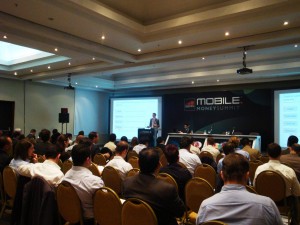 Today, the beautiful city of Rio de Janeiro has been the host of the 5th Mobile Money for the Unbanked Working Group. The MMU Programme is at its midpoint and since its inception in February 2009, we have not only built a strong grant portfolio of over 19 projects; but have also witnessed the emergence of approximately 147 mobile money deployments worldwide. In the past twelve months, the MMU programme has set itself a goal – to provide mobile money services to 20 million unbanked consumers by 2012. To stimulate deployments in countries where Mobile Money doesn’t already exist, to extend the reach of mobile money, particularly to low income consumers, and to increase the range of financial services offered via mobile, beyond payments.
Today, the beautiful city of Rio de Janeiro has been the host of the 5th Mobile Money for the Unbanked Working Group. The MMU Programme is at its midpoint and since its inception in February 2009, we have not only built a strong grant portfolio of over 19 projects; but have also witnessed the emergence of approximately 147 mobile money deployments worldwide. In the past twelve months, the MMU programme has set itself a goal – to provide mobile money services to 20 million unbanked consumers by 2012. To stimulate deployments in countries where Mobile Money doesn’t already exist, to extend the reach of mobile money, particularly to low income consumers, and to increase the range of financial services offered via mobile, beyond payments.
These are some of the highlights from today’s session: Neil Davidson from the GSMA provided us with a snapshot of each MMU project and what the industry can expect to learn from them. Moreover, Paul Leishman expanded on last year’s mobile money framework, by mapping out the key elements of a successful mobile money deployment, highlighting some of the factors which operators need to consider when building out each one. This session highlighted the key things that we have seen operators get wrong with their mobile money service, and how to put them right.
In addition, in the last twelve months, a number of success stories have been announced where operators have signed up significant numbers of customers to a mobile money service; however, in order for a mobile money deployment to be sustainable, customers need to not only sign up, they need to become active users of the service. This is a challenge that a number of operators are facing right now – and Gabriel Ferreira from Oi Paggo (Brazil); Richard Mwami from MTN (Uganda); and Jose Crisanto Magno from SMART (Philippines) provided an opportunity to hear about their approaches to switching on the customers that they have acquired. Also, a selection of technology vendors, such as Fundamo, Sybase 365 and Gemalto, who have implemented mobile money platforms around the world, shared with us their insights. And the Bill and Belinda Gates Foundation, who are sponsors of our programme, shared with us their perspectives on what it takes to successfully scale up.
In terms of sophistication, we’re seeing an increase in the range of services being offered by mobile network operators. From salary payments – highlighted by the successful pilot by Roshan in Afghanistan, where a number of Afghan National Police officers receive their salary via M-Paisa, to Robi’s mRemittance service in Bangladesh. Furthermore, Peter Goldstein from InterMedia’s innovative AudienceScapes’ project, surveyed its detailed, original survey data to test key assumptions about cell phone access and use, particularly in rural areas and provided us with key insights about various uses of mobile phones, particularly for mobile money, from a ground-up perspective. Dr. Bill Maurer from the Institute for Money, Technology and Financial Inclusion at the University of California also explained from a sociological perspective how customers at the BOP use their mobile phones to access financial services.
Tomorrow is the first official day of the 2010 Mobile Money Summit and we are looking forward to the exchange of more learnings and the display of new technologies in the world of mobile money.

